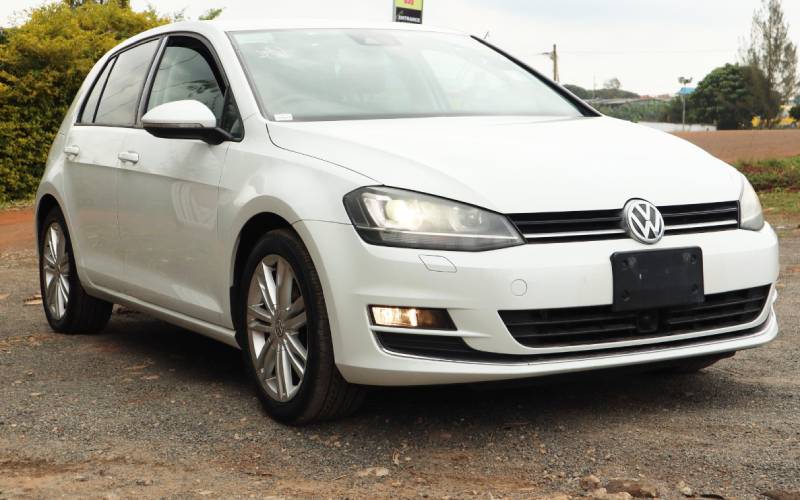The Volkswagen Golf is one of the success stories from Wolfsburg City in Germany.
Punchy, classy and dependable are all adjectives that describe the compact vehicle from Lower Saxony state in northwestern Germany.
Since 1974 (forty-eight years ago), the car has been in production.
In Kenya, its trading name is the Golf. In the United States it is known as Volkswagen Rabbit and in Mexico it is marketed as Volkswagen Caribe.
The vehicle is in its eighth generation now, with the first being referred to as the MK1, and the eighth known as MK8.
Universally, the MK is an abbreviation for “Mark” which means a generation of a model or revision number. Each generation represents a design, and a higher MK number represents a new generation of that vehicle.
The MK1 was first produced in 1974; the MK2 in 1983; the MK3 in 1991; the MK4 in 1997; the MK5 in 2003; the MK6 in 2008; the MK7 in 2012 and the current generation, the MK8, in 2019.
In Kenya, the vehicle that is being sold at the bazaars currently, is the MK7 that was in production between 2012 and 2019. The seven-year import policy on vehicles makes the 2015 Volkswagen Golf the most common among car dealers across Kenya.
A 2015 version of the car could cost you between Sh1.4 million and Sh1.8 million depending on mileage, features and country of import.
The 2015 Golf comes in two engine sizes – 1,400cc petrol engine or the 1,800cc turbo engine. However, there is a rare diesel engine version of the car (2,000cc) that produces 150 horsepower and 236 pound-foot of torque.
The 1,400cc Golf produces 125 horsepower, accelerating from 0 to 100 kilometres per hour in 10 seconds, while the 1,800cc turbocharged Golf produces 170 horsepower and accelerates from 0 to 100 kilometres per hour in 8.1 seconds.
The petrol version is known as the TSI (Turbocharged Stratified Injection) engine, while the diesel equivalent is known as the TDI (Turbocharged Direct Injection) engine. Most diesel versions come with manual transmission, while the petrol versions come with automatic transmission.
Most of the Golf cars are two-wheel drive, with the rare R edition, known as the R Line, driving on all the four wheels.
Volkswagen R is the brand used by Volkswagen to indicate a sport or high performance model. An "R" badge is placed on the grille, front fenders and trunk of R-model vehicles to indicate the vehicle's trim level.
The VW Golf comes with a 45-litre fuel tank. That would mean that at the current petrol price of Sh150.12 in Nairobi, it would cost you Sh6,755 to fill it. The diesel equivalent would set you back Sh5,895 to fill it at the current price (Sh131.0 for a litre of diesel).
On good driving in urban centres, the 1,400cc Golf could give you some 10 kilometres per litre. That figure improves to 12 kilometres per litre on highway driving.
On full tank, the vehicle could take you some 500 kilometres before a need to refuel.
The Golf has a 380-litre boot space with the seats up and 1,237 litres with them down. In its range, it’s more spacious compared to its rivals such as the Mini Cooper that has a boot space of 211 litres. However, it has the same boot size as its rival in the BMW line, the 116i.
On safety and stability, the Golf enjoys a five-star rating, meaning its reliability on the two areas is almost-perfect. The full five stars were awarded in 2012, partly thanks to the curtain and driver's knee airbags and stability control, which are all standard. Plus, there are systems in place that automatically brake for you if it senses a low-speed collision to stop you getting too close to the car in front.
Francis Wahome, a 36-year-old Nairobi resident, owns a 2013 VW Golf.
“The car feels sporty and stylish. Its daytime running lights and headlights design are attractive,” he said.
With a top speed of 260 kilometres per hour, the five-door compact vehicle offers more figures on the speedometer for the thrill-lovers.
With its kerb weight of 1,438 kilogrammes (weight while empty), the Golf is a solid and stable vehicle, even when driven at high speed. It can carry cargo, including human beings, totalling 580 kilogrammes.
One of the biggest undoing of the VW Golf, is its ground clearance – 5.1 inches. It’s too low, forcing one to try hard to manoeuvre while going over speed bumps.
“I live in Syokimau. And you know the amount of road construction that has been taking place because of the Nairobi Expressway. My car being too low, often leaves me with a dented front bumper and a bruised undercarriage,” said Francis Wahome, a Golf owner.
“My insurer warned me against adjusting its ground clearance, saying should an accident occur, they won’t process my claim,” he said.
Pascal Ohito, a mechanic on Mombasa Road, told The Standard that the Golf is a good car generally.
“Its problem is on the cost of spare parts. If you can afford a car, but don’t have a surplus disposable income, then the Golf is not a vehicle you should consider buying,” said Ohito.
Dickson Musungu, a car electrician in South B, Nairobi, says most Golf owners report malfunctioning of the power window.
“The Golf’s power window controller often fails with time due to old age, but mostly as a result of exposure to water; either at the car wash or rain droplets,” said Musungu.
The car electrician further said that the vehicle’s cooling system also fails regularly.
Other problems that the Golf is prone to include higher than normal fuel consumption, rattling sound from the engine, thermal breakdown, stiff gear changes, suspension issues due to problems with the anti-roll bar bushes, door leaks, hot ABS unit, unresponsive brakes, grinding from the rear, struggle to shift to the fifth gear and engine misfiring.
The VW Golf also has a notorious issue with its camshaft-driven high-pressure fuel pump causing the rattling sound from the engine. One should replace theirs after every 32,000 kilometres, even if no rattling sound is heard.
 The Standard Group Plc is a multi-media organization with investments in media
platforms spanning newspaper print operations, television, radio broadcasting,
digital and online services. The Standard Group is recognized as a leading
multi-media house in Kenya with a key influence in matters of national and
international interest.
The Standard Group Plc is a multi-media organization with investments in media
platforms spanning newspaper print operations, television, radio broadcasting,
digital and online services. The Standard Group is recognized as a leading
multi-media house in Kenya with a key influence in matters of national and
international interest.
 The Standard Group Plc is a multi-media organization with investments in media
platforms spanning newspaper print operations, television, radio broadcasting,
digital and online services. The Standard Group is recognized as a leading
multi-media house in Kenya with a key influence in matters of national and
international interest.
The Standard Group Plc is a multi-media organization with investments in media
platforms spanning newspaper print operations, television, radio broadcasting,
digital and online services. The Standard Group is recognized as a leading
multi-media house in Kenya with a key influence in matters of national and
international interest.










